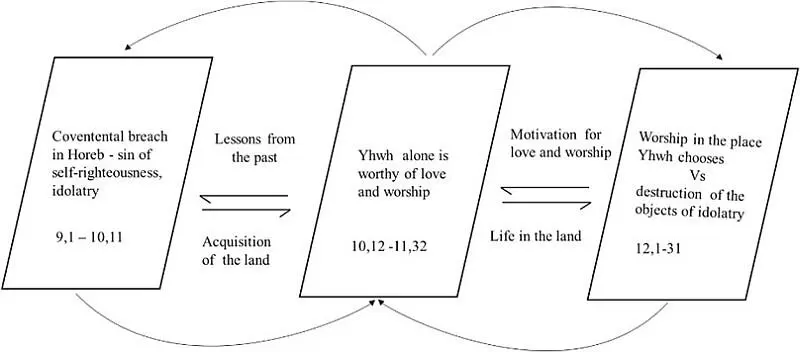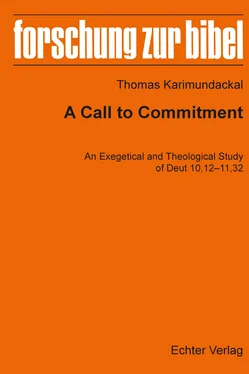1 ...6 7 8 10 11 12 ...20 g) Beginning and ending:
a) As noted above 12,1 follows closely 11,31-32 by repeating the references to the gift of the land, statutes and judgments. Thus, it shows that there is a smooth transition from 10,12-11,32 to the Law Code (chs. 12-26). 65
b) Deut 12 opens with the command to destroy the religious sites and objects of the “nations” (v2-4) and closes with a similar warning not to follow the ways of the nations (v29-31). Thus, v2-4 and v29-31 encompass the entire unit with an emphasis on the polemic behavior of the nations, how they “served their gods” and inviting Israel to remain distinct from the surroundding nations. The identical vocabulary of v4 and v31 (לא־תעשׂון כן ליהוה אלהיכם) also suggests an intrinsic relationship between these surrounding units (12,1-4 and 12,29-31). 66
c) Deut 12,29-31 also serve as a transitional passage to ch. 13. Deut 13,1 complements 12,31a: Israel may worship Yhwh only in the ways he commands, no less and no more. Therefore, as a transitional unit, 12,29-13,1 function as a bridge between ch. 12 and ch. 13, expressing two related principles: Israel should not worship the Lord in the ways that the “nations” worship their gods (12,29-31), and they should not add to Yhwh’s commandments nor subtract from them (13,1). Furthermore, the question at v30 (how do these nations serve their gods?) anticipates the three temptations described in ch. 13 (cf. 13,2.6.13). Thus, there is a natural link between the closing verses of ch. 12 (v29-31) and ch. 13. 67
Considering the arguments mentioned above, on contextual and text-linguistic grounds, we can conclude that ch. 12 is separate from 10,12-11,32 and begins the specific stipulations of the Law Code.
2.2.3 Conclusion
As we have seen in 2.1 and 2.2, Deut 9,1-10,11 and 12,1-31 remain distinct from Deut 10,12-11,32 on contextual and text-linguistic grounds. However, the repetition of certain phrases, themes and motifs shows their mutual relationship and provides a larger contextual significance to 10,12-11,32.
As the people of Israel is preparing to resume its journey to take possession of the land (10,11) its negative portrait in 9,1-10,11 is intended to provide lessons for its future life in the land (11,8-32). The memory of their sin - sin of idolatry - and the broken tablets (covenantal breach in Horeb in 9,7-10,5) should be a permanent warning (9,7 זכר אל־תשׁכח) for their life in the land. The conceit of their self-righteousness (9,1-6) will only lead them away from the Lord and to the punishment by Yhwh. And the acquisition of the land will not be due to their righteousness (9,4.5.6 צדקה) but owing to Yhwh’s graciousness and faithfulness to his promises to their forefathers. Thus, the negative foil of Israel’s past in 9,1-10,11 motivates them to love and serve the Lord alone (cf. 10,12-11,7) and to be instrumental in acquiring the land that the Lord is giving to them (cf. 11,8-32).
The instructions in ch. 12 initiate ‘the statutes and the judgments’ to which Israel must adhere in the land and for which Moses has prepared the people at length in 10,12-11,32 (chs. 1-11). The keeping of ‘the statutes and the judgments’ is closely related to Israel’s life in the land (v1). Israel’s undivided loyalty to the Lord, i.e. the way Israel worships its God, will determine the quality of their future life in the land. Yhwh has given them a land as he promised to their fathers (11,9.21.25; 12,1.20; cf. 7] נתןx]: 11,9. 17.21.31; 12,1.9.10) and now as a faithful response they must bring the produce of the land to the place he chooses (12,5.11.14.18.21.26), as an offering to the Lord (12,6.11.13.14). It is this place that Israel must seek (v5) and not the gods of the land (v30) and the detestable practices associated with their cult (v2-4.29-31).
In short, Deut 10,12-11,32 stand between 9,1-10,11 and 12,1-31 focusing on Israel’s single devotion to the Lord. This positioning of Deut 10,12-11,32 can be graphically depicted as follows:

3. Translation and text-critical notes on the text
The text wil be translated as literal as possible and the variant readings in the textual witnesses will be examined to clarify the textual difficulties, as well as linguistic and stylistic matters. 68A comparison with the important textual witnesses, such as the Samaritan Pentateuch (Smr), 69Septuagint (LXX) 70and the Qumran manuscripts 71will also bring out the adequacy of the MT as the basis for the exegesis.
3.1 Qumran Manuscripts
The following Qumran manuscripts attest the text under consideration:
| Texts Attested |
Manuscript |
Publication |
Date of the Manuscripts |
| 10,12-15 |
4Q38 (4QDeut l) |
DJD XIV 72 |
ca. 50 BCE 73 |
| 10,12-11,17; 11,18-21 |
4Q128 (4QPhyl a) |
DJD VI 74 |
between the middle of 2 ndcentury BCE and 1 stJewish – Roman war 75 |
| 10,12-11,7; 11,7-12 |
4Q138 (4QPhyl k) |
DJD VI 76 |
between 1 stcentury BCE and 1 stcentury CE |
| 10,22-11,3; 11,18-21 |
4Q143 (4QPhyl p) |
DJD VI 77 |
” |
| 10,14-11,2 |
4Q150 (4QMez b) |
DJD VI 78 |
middle of 1 stcentury CE 79 |
| 10,12-20 |
4Q151 (4QMez c) |
DJD VI 80 |
2 ndpart of 1 stcentury BCE 81 |
| 10,12-19; 10,21-23;11,2-3; 11,1; 11,6-12 |
8Q3 (8QPhyl) |
DJD III 82 |
1 stcentury CE 83 |
| 10,12-11,21 |
8Q4 (8QMez) |
DJD III 84 |
37- 4 BCE 85 |
| 10,17-18; 10,21-11,1; 11,8-11 |
1Q13 (1QPhyl) |
DJD I 86 |
|
| 11,3; 11,9-13.18 |
4Q30 (4QDeut c) |
DJD XIV 87 |
150-100 BCE 88 |
| 11,4-8 |
4Q144 (4QPhyl q) |
DJD VI 89 |
between 1 stcentury BCE and 1 stcentury CE |
| 11,4 |
4Q122 (4QLXXDeut) |
DJD IX 90 |
early or middle 2 ndcentury BCE 91 |
| 11,6-13 |
4Q38 (4QDeut j) |
DJD XIV 92 |
ca. 50 CE 93 |
| 11,6-13 |
4Q38 (4QDeut k1) |
DJD XIV 94 |
30-1 BCE 95 |
| 11,13-21 |
4Q130 (4QPhyl c) |
DJD VI 96 |
beginning of 1 stcentury CE 97 |
| 11,13-17. 19-21 |
4Q131 (4QPhyl d) |
DJD VI 98 |
between 1 stcentury BCE and 1 stcentury CE |
| 11,13-21 |
4Q136 (4QPhyl i) |
DJD VI 99 |
” |
| 11,19-21 |
4Q146 (4QPhyl s) |
DJD VI 100 |
” |
| 11,28; 11,30-12,1 |
4Q45 (4QPaleoDeut r) |
DJD IX 101 |
100-25 BCE 102 |
| 11,27-30 |
1Q4 (1QDeut a) |
DJD I 103 |
50-25 BCE 104 |
| 11,30-31 |
1Q5 (1QDeut b) |
DJD I 105 |
30-1 BCE 106 |
Qumran manuscripts, all dated before the second century CE, provide extensive information on the MT and the relation between the textual witnesses. Even though some of these manuscripts are quite fragmentary, all of them appear to follow the full orthography typical of Qumran manuscripts. Though it is rather difficult to assign a textual affiliation to these manuscripts due to their fragmentary nature, some of the manuscripts show resemblance with the Smr and LXX. 107In general, most of the manuscripts agree with the MT, although in some cases they differ with some significant variants as we see below.
3.2 Translation and textual notes
Deut 10,12-22
| ועתה ישׁראל |
12a |
And now Israel, |
| מה יהוה אלהיך שׁאל מעמך |
12b |
what does the Lord your God demand 108from you, |
| כי אם־ליראה את־יהוה אלהיך |
12c |
but to fear the Lord your God |
| ללכת בכל־דרכיו |
12d |
to walk in all His ways |
| ולאהבה אתו |
12e |
and to love Him, |
| ולעבד את־יהוה אלהיך |
12f |
and to serve the Lord your God with all your heart and with all your soul, |
| בכל־לבבך ובכל־נפשׁך |
|
|
| לשׁמר את־מצות יהוה ואת־חקתיו |
13a |
to keep the commandments of the Lord and his statutes |
| אשׁר אנכי מצוך היום לטוב לך: |
13b |
which I command you this day for your good? |
| הן ליהוה אלהיך השׁמים ושׁמי השׁמים הארץ וכל־אשׁר־בה |
14a |
Behold, to the Lord your God belong the heavens and the heaven of heavens, 109the earth and all that is in it. |
| רק באבתיך חשׁק יהוה |
15a |
Only 110in your fathers the Lord attached 111 |
| לאהבה אותם |
15b |
to love them, |
| ויבחר בזרעם אחריהם |
15c |
and he chose their seed after them, |
| בכם מכל־העמים כיום הזה |
15d |
you, from all the peoples, as this day. |
| ומלתם את ערלת לבבכם |
16a |
And circumcize the foreskin 112of your heart, |
| וערפכם לא תקשׁו עוד: |
16b |
and stiffen your neck no more! |
| האלהים כי יהוה אלהיכם הוא אלהי |
17a |
For the Lord your God, he is the God of gods |
| ואדני האדנים |
17b |
and the Lord of lords |
| האל הגדל הגבר והנורא |
17c |
the great God, the mighty and the awesome |
| אשׁר לא־ישׂא פנים |
17d |
who does not lift up faces |
| ולא יקח שׁחד: |
17e |
and takes no bribe. |
| עשׂה משׁפט יתום ואלמנה |
18a |
He does justice for the orphan and the widow |
| ואהב גר |
18b |
and he loves the stranger |
| לתת לו לחם ושׂמלה: |
18c |
by giving him food and clothing. |
| ואהבתם את־הגר |
19a |
And you shall love the stranger, |
| כי־גרים הייתם בארץ מצרים: |
19b |
for you were strangers in the land of Egypt. |
| את־יהוה אלהיך תירא |
20a |
You shall fear the Lord your God; |
| אתו תעבד |
20b |
him shall you serve, |
| ובו תדבק |
20c |
and to him you shall cleave |
| ובשׁמו תשׁבע: |
20d |
and by his name you shall swear. |
| הוא תהלתך |
21a |
He is your praise |
| והוא אלהיך |
21b |
and he is your God, |
| אשׁר־עשׂה אתך את־הגדלת |
21c |
who has done for you 113these great and |
| ואת־הנוראת האלה |
|
awesome things |
| אשׁר ראו עיניך: |
21d |
which your eyes have seen. |
| בשׁבעים נפשׁ ירדו אבתיך |
22a |
With seventy persons114 your fathers went |
| מצרימה |
|
down to Egypt |
| ועתה שׂמך יהוה אלהיך ככוכבי |
22b |
and now the Lord your God has made you |
| השׁמים לרב: |
|
as the stars of heaven for multitude. |
Deut 11
Читать дальше













